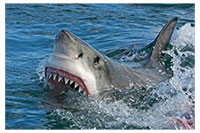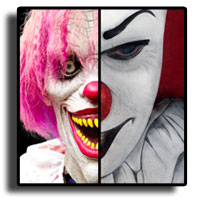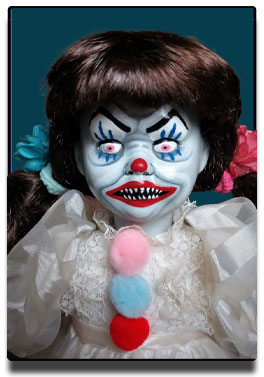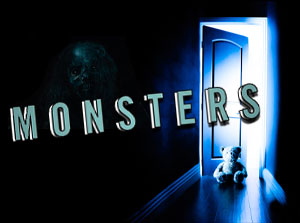| Have you ever wanted to go looking for the Loch Ness Monster? Or wondered what the Baba Yaga flies around in or even where to find a three-headed dog? Or even just the monsters under the bed. The most scary monsters that will give you a real fright if they chose to hide under your bed. |
 |
|
 |
|
 The International Shark Attack File (ISAF) from the Florida Museum of Natural History looked into 120 reported shark-human interactions across the globe in 2023. Among them, there were 69 unprovoked shark attacks, exceeding the five-year average of 63 attacks per year. However, experts stress that this doesn’t necessarily mean shark attacks are on the rise. The International Shark Attack File (ISAF) from the Florida Museum of Natural History looked into 120 reported shark-human interactions across the globe in 2023. Among them, there were 69 unprovoked shark attacks, exceeding the five-year average of 63 attacks per year. However, experts stress that this doesn’t necessarily mean shark attacks are on the rise. |
 |
|
 |
|
 The sandman. when I was little and wouldn't go to sleep my mother would tell me the sandman will come and put sand in your eyes so go to sleep. Well that was terrifying and I would lay there wondering just when he was going to show up and if he did how could I talk him out of putting sand in my eyes. It then occurred to me I could throw a glass of water on him and that would wash him away. So every night I would ask my mom for a glass of water and leave it on my nightstand. That way I had my weapon all ready if he decided to show up. I don't remember how long this went on for but yes this was a scary thing to a little girl. Here is the nice version of the sandman . The sandman. when I was little and wouldn't go to sleep my mother would tell me the sandman will come and put sand in your eyes so go to sleep. Well that was terrifying and I would lay there wondering just when he was going to show up and if he did how could I talk him out of putting sand in my eyes. It then occurred to me I could throw a glass of water on him and that would wash him away. So every night I would ask my mom for a glass of water and leave it on my nightstand. That way I had my weapon all ready if he decided to show up. I don't remember how long this went on for but yes this was a scary thing to a little girl. Here is the nice version of the sandman . |
 |
|
 |
|
|
|
|
 Werewolf, in European folklore, a man who turns into a wolf at night and devours animals, people, or corpses but returns to human form by day. Some werewolves change shape at will; others, in whom the condition is hereditary or acquired by having been bitten by a werewolf, change shape involuntarily, under the influence of a full moon. If he is wounded in wolf form, the wounds will show in his human form and may lead to his detection. Belief in werewolves is found throughout the world. The psychiatric condition in which a person believes he is a wolf is called lycanthropy. Werewolf, in European folklore, a man who turns into a wolf at night and devours animals, people, or corpses but returns to human form by day. Some werewolves change shape at will; others, in whom the condition is hereditary or acquired by having been bitten by a werewolf, change shape involuntarily, under the influence of a full moon. If he is wounded in wolf form, the wounds will show in his human form and may lead to his detection. Belief in werewolves is found throughout the world. The psychiatric condition in which a person believes he is a wolf is called lycanthropy.
Read More >>>
In countries in which wolves are not common, the monster may assume the form of another dangerous animal, such as the bear, tiger, or hyena. In French folklore, the werewolf is called loup-garou. France was particularly afflicted with reports of them in the 16th century, and there were many notable convictions and executions of loups-garous. As a subject for 20th-century horror films, the werewolf tradition is second only to the vampire tradition in popularity. Werewolves are believed to turn into after death.
Werewolves among others. Similarly, the Inuit giant monster wolf Amarok
Grendel and his mother attack at night, as do other trolls, ogres and giants
Ghosts appear at night.
Spectral dogs, the black dogs of Britain especially, appear at night.
Witches and hags do their mischief at night in mythology.
The sack man and his counterparts like Bubak the scarecrow, Dzunuḵ̓wa the giant ogre and the Nachtkrapp search for children at night to carry away
"Various forms of Aswang come out at night to hunt the unwary. The night is also a time for the Yokai. On summer nights, there is the Hyakki Yagyō where Yokai, Oni, Ghosts, and all sorts of creatures parade down the roads. Goblins and elves pop out at night to do their work; the fey folk cross from their world to ours at nights.
Most monsters appear during the night; humans fear the darkness, the cold, the alien world of nightfall. And it is when our imaginations run wild and create a whole menagerie of monsters.
|
 |
|
 |
|

>The evil clown, also known as the killer clown, is a subversion of the traditional omic clown character, in which the playful trope is instead depicted in a more disturbing nature through the use of horror elements and dark humor.
American serial killer and rapist John Wayne Gacy became known as the Killer Clown when arrested in 1978, after it was discovered he had performed as Pogo the Clown at children's parties and other events; however, Gacy did not actually commit his crimes while wearing his clown costume.
Read More >>>
The concept of the evil clown is related to the irrational fear of clowns, known as coulrophobia, a neologism coined in the context of informal.
 Similarities between a clown's appearance and the cultural depictions of demons and other infernal creatures, noting "[the clown's] chalk-white face in which the eyes almost disappear, while the mouth is enlarged to a ghoulish bigness, looks like the mask of death". Similarities between a clown's appearance and the cultural depictions of demons and other infernal creatures, noting "[the clown's] chalk-white face in which the eyes almost disappear, while the mouth is enlarged to a ghoulish bigness, looks like the mask of death".
According to psychology professor Joseph Durwin at California State University, Northridge, young children are "very reactive to a familiar body type with an unfamiliar face". Researchers who have studied the phobia believe there is some correlation to the uncanny valley effect. Additionally, clown behavior is often "transgressive" (anti-social behavior) which can create feelings of unease.
|
 |
|
 |
|
|
| |
|




